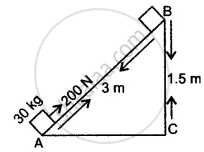Advertisements
Advertisements
Question
A uniform circular motion is an accelerated motion. Justify it.
Solution
In uniform circular motion, a particle travels equal distances along the circular path in equal intervals of time, so the speed of particle is uniform. But the direction of motion of the particle changes at each point of circular path. Due to continuous change in direction of motion, the velocity of the particle is not uniform (or velocity is variable) i.e., the motion is accelerated.
APPEARS IN
RELATED QUESTIONS
A pair of bullocks exerts a force of 140 N on a plough. The field being ploughed is 15 m long. How much work is done in ploughing the length of the field?
Work is said to be done by a forte only when ................
No work is done by a force if the body
State two conditions when no work is done by a force.
State the S.I. unit of energy.
Define 1 joule of energy.
A boy of mass 40 kg climbs up the stairs and reaches the roof at a height 8 m in 5 s. Calculate:
- the force of gravity acting on the boy,
- the work done by him against the force of gravity,
- the power spent by boy. (Take g = 10 m s-2)
Find the kinetic energy of a body of mass 1 kg moving with a uniform velocity of 10 m s-1.
If the work done by a force in moving an object through a distance of 20 cm is 24.2 J, what is the magnitude of the force?
Can work done be zero even if force acts on the body?
If an electric bulb of 100 watt is lighted for 2 hours, how much electric energy would be consumed?
A bullet is of mass 'm' g and is moving with a velocity 'v' m/s. Find the kinetic energy of the bullet when
(a) The mass is doubled,
(b) The velocity is tripled.
State the amount of work done by an object when it moves in a circular path for one complete rotation. Give a reason to justify your answer.
What do you understand by the term energy? Is energy a scalar or vector? How is the energy possessed by a body measured?
A block of mass 30 kg is pulled up a slope, as shown in diagram with a constant speed, by applying a force of 200 N parallel to slope.
A and B are initial and final positions of block.

(i) Calculate the work done by force in moving the block from A to B.
(ii) Calculate P.E. gained by block. [g=10ms-2]
A car is accelerated on a levelled road and attains a velocity 4 times of its initial velocity. In this process the potential energy of the car
